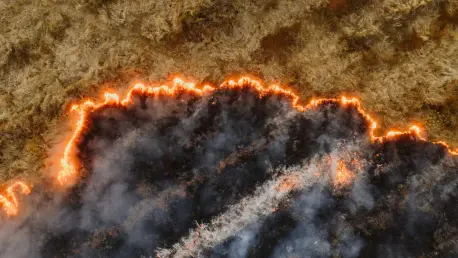Searing Realities: The Escalating Wildfire Challenge
In the heart of the Iberian Peninsula, the landscapes of Spain and Portugal have been transformed into battlegrounds against relentless wildfires this year, with over 640,000 hectares reduced to ash. This staggering loss, equivalent to four times the size of Greater London, is not just a natural disaster but a glaring signal of a market-shifting crisis fueled by climate change. According to recent scientific analysis, the hot, dry conditions driving these infernos are now 40 times more likely compared to pre-industrial times, presenting a profound challenge for the insurance and reinsurance sectors. This analysis delves into the market dynamics reshaped by these escalating risks, exploring how insurers can navigate a peril that has transitioned from episodic to chronic. By examining current trends, data-driven insights, and future projections, this piece aims to equip stakeholders with the knowledge needed to adapt to a rapidly warming world where wildfires are redefining exposure landscapes.
Market Trends and Data-Driven Insights
Wildfire Risk Surge: A Climate-Driven Shift
The Iberian wildfire crisis marks a pivotal moment for the insurance market, as climate change emerges as a dominant force multiplier. Scientific findings indicate that the probability of extreme fire-prone weather has surged dramatically, with heat and drought conditions intensifying by roughly a third in severity. This shift is particularly pronounced in the Mediterranean region, where prolonged summers and diminishing rainfall have created ideal conditions for ignition and rapid spread. For insurers, this translates into a fundamental recalibration of risk portfolios, as what were once rare events now recur with alarming regularity, demanding updated actuarial models that account for heightened frequency and loss potential.
Beyond the immediate data, the market must grapple with the implications of rural depopulation across Spain and Portugal. Abandoned agricultural lands have become dense with unmanaged vegetation, acting as fuel for larger, more destructive fires. This trend, coupled with longer fire seasons, challenges traditional underwriting assumptions that often underestimated European wildfire exposure compared to North American benchmarks. Insurers now face a pressing need for localized data on fuel loads and land use patterns to refine risk assessments and avoid systemic underpricing of this growing threat.
Scale of Impact: Quantifying Losses and Exposures
The sheer magnitude of destruction this year provides a sobering dataset for market analysis. With Spain alone recording 380,000 hectares burned since the start of the year, the region has endured one of its most catastrophic fire seasons on record. Evacuations affecting tens of thousands in Spain and about a thousand in Portugal mitigated human casualties, yet the economic and ecological losses are staggering. National parks sheltering endangered species and cultural landmarks along historic routes have suffered irreversible damage, amplifying indirect costs that insurers must now factor into claims and liability projections.
From a market perspective, the concurrency of wildfire events across Europe during this season has exposed vulnerabilities in reinsurance structures. Unlike isolated incidents, simultaneous outbreaks strain capacity and highlight the risk of correlated losses, pushing reinsurers to rethink aggregate exposure limits. Loss volatility further complicates pricing strategies, as existing models—often calibrated to different geographic and climatic contexts—fail to capture the unique dynamics of European fire behavior, such as wind-driven spread across varied terrains. This data gap underscores an urgent market need for tailored analytics to ensure financial stability.
Insurance Sector Challenges: Adapting to Chronic Perils
The transition of wildfires from occasional catastrophes to persistent risks is reshaping the insurance landscape in profound ways. Evolving exposures driven by societal shifts, such as rural exodus, have left vast areas more combustible, directly impacting property and business interruption coverages. Insurers are now tasked with addressing not only direct damages but also secondary perils like smoke and ash contamination, which extend loss scopes beyond initial fire boundaries. Additionally, liability risks in sectors like utilities, where infrastructure may contribute to ignition, are becoming a critical concern for underwriters.
Market data suggests that current risk accumulation controls are insufficient for handling the scale of concurrent events witnessed this year. Reinsurance frameworks, designed for singular or regionally contained disasters, are being tested by the widespread nature of these fires, necessitating revised structures to manage aggregate losses. The volatility in claims also points to a broader market trend: the inadequacy of North American-centric wildfire models in predicting European outcomes. Insurers must pivot toward granular, region-specific tools to address these discrepancies, ensuring premiums reflect true exposure while maintaining accessibility for policyholders.
Future Projections: Navigating an Intensifying Risk Landscape
Looking ahead, projections indicate that wildfire risk in Europe will continue to escalate without significant global action on climate mitigation. Fire seasons are expected to lengthen and intensify over the next few years, with heat extremes becoming more frequent in the Mediterranean basin. For the insurance market, this forecast suggests persistent upward pressure on claims and capital requirements, potentially rendering some high-risk areas uninsurable if adaptation lags. Emerging technologies, such as satellite imagery for real-time fuel load monitoring, offer promising avenues for refining risk models, though their adoption remains uneven across the sector.
Economic instruments like catastrophe bonds could also play a larger role in distributing wildfire risk, provided transparent triggers and reliable data build investor confidence. Regulatory shifts may further influence market dynamics, with potential mandates for stricter land management practices or incentives for community-level prevention. Projections from industry analyses suggest that insurers integrating these innovations will likely gain a competitive edge, while those slow to adapt risk significant portfolio imbalances. The market must brace for a future where wildfire exposure is not a peripheral concern but a core component of catastrophe planning.
Reflecting on the Path Forward
Looking back, the Iberian wildfire crisis served as a stark reminder of how climate change has redefined market risks for insurers, with conditions for such devastating fires becoming 40 times more likely. The immense scale of destruction, coupled with the concurrency of events across Europe, has exposed critical gaps in traditional risk models and reinsurance frameworks. Challenges like rural depopulation and loss volatility have compounded the issue, pushing the industry to confront a peril that has evolved into a chronic threat. Moving forward, strategic adaptation must prioritize the development of localized risk assessment tools and the incentivization of mitigation measures, such as premium credits for fire-resistant construction. Collaboration between insurers, governments, and communities to fund landscape-scale prevention initiatives offers a tangible solution to reduce vulnerability. As the market continues to evolve, embracing technological innovations and exploring economic instruments like catastrophe bonds will be essential to manage exposure and ensure long-term resilience in a warming world.









